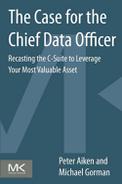Executive Summary
How to Obtain a Data Advantage
Data are an organization’s sole, non-depletable, non-degrading, durable asset. This book makes the case for dedicating an individual to leverage them as assets – a Chief Data Officer or CDO. Only through a proficient individual:
can organizations expect to leverage their data assets. Data possesses properties worthy of additional investment. Many existing CDOs1 are fatally crippled, lacking one or more of these necessary pillars. Often organizations have some or all components already in place but not operating in a coordinated manner. By the end of the book, you will understand these pillars, why each is necessary (but insufficient), and what do to about it. Briefly this book covers:
1. Engineering our organizations to deal with the impending data tsunami.
Data and its use are becoming increasingly important to your organization. If you haven’t already heard of big data and how it is ‘transforming’ your world, you will soon. Data’s importance and scale continues to increase at an exponential rate. Difficult as it is to manage now, data management (DM) is going to get much more difficult, very quickly, based just on the forecast volume and dimensionality increases. In the face of this onslaught, we must transform our concept of DM and organizational processing: from part of IT, to supporting an organization engineered to leverage its data and surf the data tsunami.
2. More than likely, you, your IT leadership, your organizational knowledge workers have not had opportunity to acquire the requisite knowledge, skills, and abilities (KSAs) to strategically leverage data as an asset.
Yet you are still responsible for well-managed data. You are all smart individuals who have proven capabilities, mastering technological change. You were never asked to learn about data and so didn’t learn much about it. As a result, less than 10% possess the KSAs required to successfully leverage data assets [representing IP equal to half of organizational valuations (Olavsrud 2012)]. The other 90% are not data-knowledgeable.2 Once the CDO/IT/non-IT knowledge workers are tasked, educated, and organized to leverage data, the organization’s performance will propel it to the head of its peer group.
3. (Until reading this) You may have been unaware that your IT leadership likely does not possess these KSAs.
You likely think of data as a part of IT. If you investigate, you will be disappointed at the time and type of attention that data gets. Fueling IT operations, data inputs and outputs must be exactly matched at the most atomic level in order to be useful. Your organization is probably spending much time, resources, and effort managing differing data requirements requiring inordinate transformation efforts. This constrains operations and saps resources – mainly from data analysis. Organizations made aware of these situations, rapidly reconfigure and take advantage of these new capabilities.
4. Your IT leadership is similarly unaware.
Your IT leadership attended appropriate training/college and learned what they were taught. The subject of DM is often never introduced. Most encountered data only in a class devoted to database management system development. Having learned what they were asked to learn, IT leaders acquired a technology-centric view of data and are largely unaware of the need for architecture/engineering-based DM KSAs. Not being data-knowledgeable, they cannot be good decision-makers about data. When these circumstances improve, it is possible to calculate the ROI obtained from data leveraging and incorporate it as a strategic organizational capability.
5. Your organization is likely unprepared to obtain a big data advantage.
Because of the above, your organization lacks repeatable processes for being able to successfully use data assets to support organizational strategy. Your data related activities are costing more, taking longer, and delivering less – your operations are similarly brittle. You are unaware of this and your organization is not taking steps to address it. Organizations making these changes are able to incorporate new technological capabilities into their overall architecture and obtain data advantages more quickly.
6. Unless you dedicate an individual to leveraging data assets, your organization will continue be unable to obtain a data advantage.
To address this challenge, name someone to be your data Chief – most are calling it a Chief Data Officer (CDO). Provide them with the necessary success pillars.
First, sole dedication to data. Fractional approaches have not worked to date – this is a full time effort. A committed focus to data-centric development (see Section 3.5) facilitates C-level data asset awareness.
Second, de-linking data asset evolution from business information system development permits your architects to develop the necessary evolutionary, strategic mindset toward data.
Third, this position must report up to the executive leadership. It is really a question of bandwidth. IT management cannot devote the requisite time/resources and is not data knowledgeable. Freeing the CDO from the IT reporting chain results in faster organizational transformation and permits increased agility.
‘Working’ from this perspective for at least a year, the CDO will understand your organizational data challenge – a prerequisite to data-knowledgeable decision-making (see our job description for the position included as Section 5.3.5).
